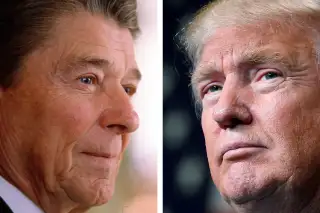Why Wall Street Is Wrong About Trump Being the Next Reagan

Investors' attitudes about Donald Trump are shifting as quickly as Trump's odds of winning did on election night.
After warning that a Trump victory would lead to an immediate 10% plunge in the stock market, Wall Street strategists have quickly warmed to the idea that Trump's win could spur economic growth.
In fact, a growing number of investors think Trump's two-pronged stimulus proposal of $1 trillion in infrastructure spending plus massive tax cuts sounds a lot like Ronald Reagan's solution to boost growth in the early 1980s — though in Reagan's case, deficit spending came in the form bigger defense outlays.
Before you jump on Wall Street's latest bandwagon, though, you have to understand why the Trump-Gipper analogy doesn't hold.
Difference #1: Employment Has Already Strengthened
"A common question from clients is whether we could get a replay of the early 1980s when Reagan cut taxes and increased spending helping trigger a big surge in U.S. growth," noted Ethan Harris, global economist at Bank of America Merrill Lynch.
That's unlikely, Harris says, in part because the U.S. economic recovery is already so mature, especially when it comes to jobs.
When Reagan took office in January 1981, the nation's unemployment rate had climbed to 7.5% and was on its way to 10.8% by December 1982.
Today, Trump will be inheriting a job market that's already been improving for more than five years. After peaking at 10% in 2009, the national unemployment rate now stands at 4.9% today. That's slightly below the 5% threshold which has historically been considered the threshold of so-called "full employment."
"The economy is already at full employment so that stimulus applied now is more likely to stoke higher inflation and interest rates than greater real GDP growth," says David Kelly, chief global strategist at J.P. Morgan Funds.
Difference #2: The Fed is Poised to Hike Rates, Not Cut Them
In January 1981, the Federal Funds rate — the rate banks charge one another on overnight loans, set by the Federal Reserve — stood at a record 19.1%. Then-Fed chairman Paul Volcker had been raising rates throughout Jimmy Carter's presidency in an effort to kill soaring inflation.
While Volcker cut rates at the start of Reagan's first year, raised them again, and then went back to cutting, one thing was clear: The long-term direction of interest rates under Reagan was down.
The Fed's ability to slash rates for years proved to the big tailwind that sparked one of the longest bull markets in stocks and bonds in history not just in the 1980s but also the 1990s.
Fast forward to today. Trump will be entering office after years in which the Fed kept short-term rates at near zero. Even if the Fed goes slow with rate hikes next year, the fact is they will be raising rates for years just to get back to normal.
Also, should inflation flare up as a result of Trump's efforts to stimulate the economy, the central bank could be more aggressive than is currently assumed.
As Goldman Sachs economists recently warned: "Core inflation and the funds rate are likely to be higher for the next few years in almost all scenarios."
Difference #3: Look at Where Capital Gains Taxes Are
Many investors on Wall Street agree with Trump that cutting taxes can help stimulate the economy — especially when it comes to capital gains taxes, which affects Wall Street directly.
But you have to put tax cuts in context.
Before Reagan, the top rate on capital gains taxes under Carter started off at 39%. When Reagan took over, he cut that to 20% — which was nearly half the rate from just a few years prior.
Today, Trump steps in with the maximum rate on capital gains only virtually the same as under Reagan. The top rate is 23.8% with the addition of the 3.8% surtax on investment income tied to the Affordable Care Act.
Trump is calling for the basic rate structure to stay the same, but for the 3.8% surtax to be repealed. That's the same rate as under Reagan, but with less impactful change.
Difference #4: Reagan Came Into Office Heralding Free Trade
Reagan made clear his feelings about globalization and free trade. As he spelled out in a 1985 speech to business leaders, "The freer the flow of world trade, the stronger the tides for human progress and peace among nations."
In fact, his administration signed into law the U.S.-Canada Free Trade Agreement, which was the forerunner to the North American Free Trade Agreement (NAFTA) that Trump criticized throughout the campaign.
Trump is clearly starting from a different place, threatening to not only renegotiate NAFTA but to impose stiff tariffs on China and Mexico.
This is why ultimately, some believe that whatever boost Trump gives to the stock market and economy now may be short lived.
J.P. Morgan's Kelly noted that late in the campaign, Trump gave a speech in which "he promised on his first day in office to direct his Treasury Secretary to label China a currency manipulator and announce his intention to renegotiate or withdraw from NAFTA."
"He also planned to begin to build a wall on the Mexican border and start rounding up more than 2 million illegal immigrants with criminal records," Kelly noted. "Needless to say, the Chinese, Mexicans, and Canadians would not take kindly to any of this, and an early, all-out trade war could have significantly negative implications for both the U.S. and global economies."